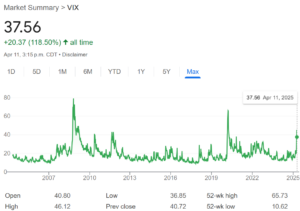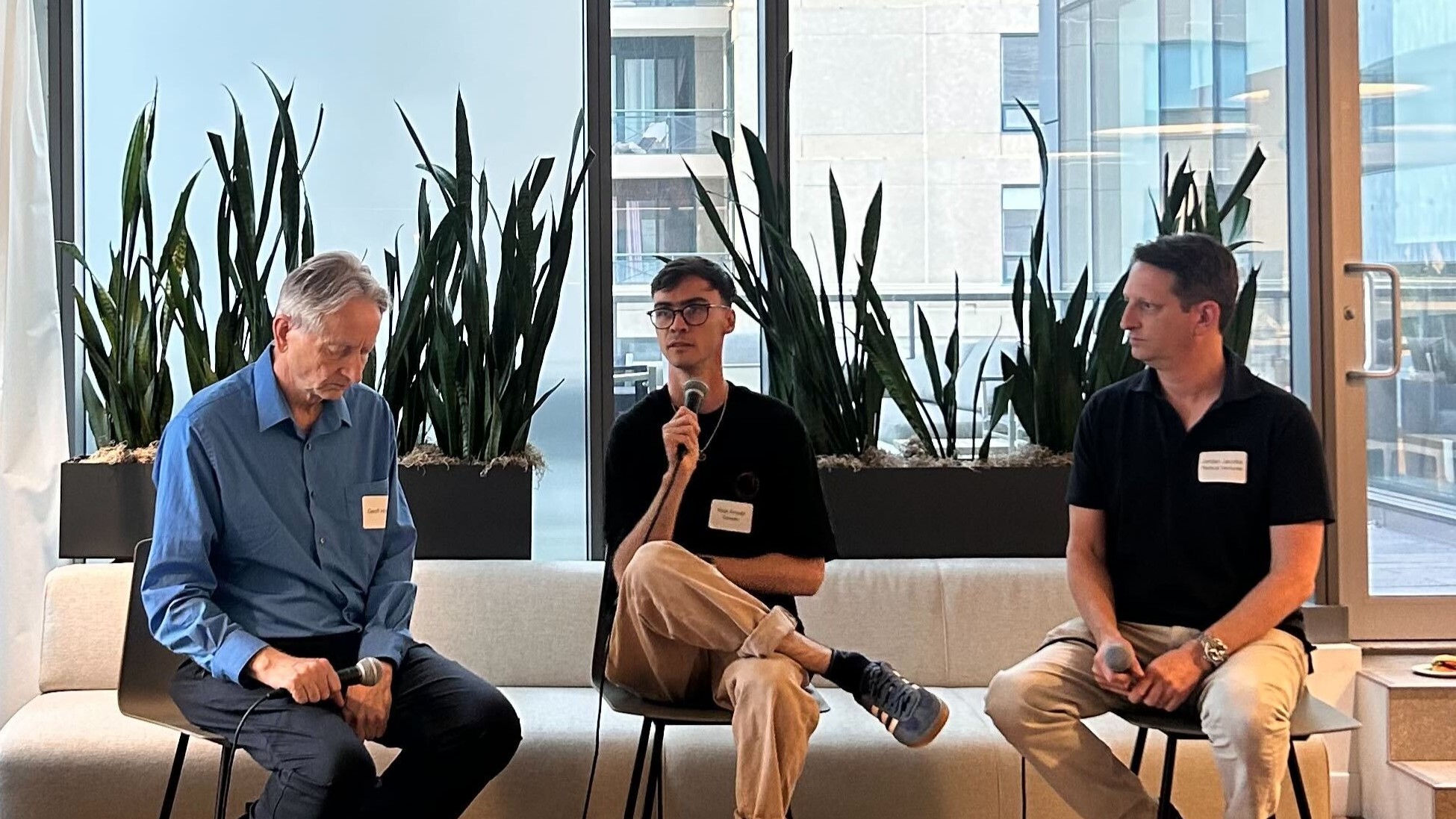As public markets react to tariff-triggered volatility, the AI startup ecosystem faces a potential recalibration. In this week’s Radical Reads, Radical Partner Ryan Shannon explores how these macro shifts impact AI startup valuations, what this means for the “AI premium,” and provides strategies for founders to navigate this changing landscape.
The global markets shuddered last week, reacting to geopolitical tensions and tariff escalations with a velocity reminiscent of past market crises. While public equity dips grab headlines, the more telling signal for the tech ecosystem is the spike in volatility. The VIX, the market’s ‘fear gauge’, has erupted to levels dwarfing recent memory, comparable to the Global Financial Crisis peak and rivalling the early pandemic shock of March 2020.

Public market investors are bracing for impact. But what does this macro tremor signify for the founders, operators, and investors navigating the frontier of AI?
Connecting Macro Shifts to Startup Valuations
Research suggests a 1% decrease in the Nasdaq generally equates to a ~0.5% decrease in Series A valuations within the next six months. Based on our analysis, this effect amplifies at later stages, hitting closer to 0.75% for growth rounds. With the Nasdaq down significantly year-to-date (~13% as of Friday, April 11th), the arithmetic implies a potential ~6.5% valuation compression at Series A and ~10% at growth stages. Behind these numbers are two tangible pressures:
- Compressed Exit Multiples: Public market downturns directly shrink the potential exit valuations (IPO or M&A) that VCs underwrite against, lowering the entry price they can justify today.
- Heightened Uncertainty: Increased global volatility clouds the future. Investors become more cautious, demanding a higher premium for risk. Capital deployment slows as more powder is kept dry, reducing overall demand for deals.
The AI Premium Under Scrutiny
Until this recent turbulence, the private AI market operated in a seemingly parallel universe defined by intense investor fervour. Standout companies commanded valuations of 50-100x ARR, a stark contrast to the best public software comparables, often trading closer to 10x.
Achieving typical venture returns from these entry points requires staggering conviction. Even accounting for the genuinely accelerated growth curves some AI companies demonstrate, these expectations were, charitably, exuberant. This phenomenon — described by some as a “bubble in a bear market” — is now on a collision course as the seemingly unstoppable momentum of AI innovation runs head-on into the immovable object of market fundamentals and macroeconomics. Now, as market compression and volatility intensify, the question arises: is this the moment rationality reasserts itself in AI startup land?
Navigating the Recalibration: What Comes Next?
This inflection point has several implications for the AI ecosystem:
- Flight to Fundamental Quality: Expect a concentration of capital. In turbulent times, investors gravitate towards perceived market leaders with demonstrable traction and clear differentiation. The strongest AI companies will likely still secure funding, potentially benefiting from reduced competition for capital.
- Valuation Correction: Headline valuations will soften, correlated to a macro contraction. However, a wholesale crash or widespread down rounds for top-tier AI players seems unlikely, given the underlying belief in the long-term technological shift.
- The Return of Fundamentals: The era of fundraising purely on narrative, team pedigree, and FOMO is waning. While vision remains crucial, concrete business results — defensible metrics, unit economics, clear paths to profitability — will increasingly dictate fundraising success. Companies will need to ‘grow into’ valuations based on traditional A/B/C stage expectations and more rational ARR multiples.
- Fundraising Timelines Extend: Investor caution translates directly into longer diligence processes. Expect more meetings, deeper data requests, and less tolerance for rushed ‘sprint’ auction rounds. Founders will need to cultivate investor relationships proactively long before initiating a formal raise. This shift, while demanding more founder time, ultimately fosters healthier partnerships.
- Cadence Between Rounds Slows: The prevalence of rapid-fire, pre-emptive funding rounds will likely decrease. Expect a return to more traditional 18-36 month cycles between raises, necessitating more rigorous capital efficiency.
- Enterprise Sales Cycles Lengthen: Macro uncertainty impacts enterprise budgets. Buyers become more cautious, procurement processes tighten, and deal cycles extend. AI startups should anticipate slower near-term ARR growth and adjust forecasts accordingly.
- Focus Shifts to Runway and Efficiency: Slower revenue growth and longer funding cycles necessitate a renewed focus on managing burn. Prudent startups will moderate hiring plans and optimize spending to extend their operational runway.
The Enduring Thesis: Build Through the Noise
The takeaway is not panic, but perspective. The fundamental drivers of the AI revolution haven’t vanished. What is changing is the environment — demanding greater discipline, resilience, and focus. The froth may dissipate, forcing a return to the fundamentals of building durable value.
This shift away from hype-driven cycles is ultimately healthy. It filters for conviction, rewards substance over signalling, and aligns incentives for long-term success. For founders, the mandate is clear: deepen customer value, master your metrics, cultivate strategic relationships, and manage capital judiciously.
We remain steadfast in our belief that this is a transformative era for the world due to the paradigm shift in technology to AI. Building category-defining companies was never supposed to be easy. The current climate is a reminder that enduring success requires navigating complexity and building with conviction, even when — especially when — the path gets rocky.
Find more of Ryan Shannon’s analysis of AI startup investing on his substack.
AI News This Week
-
Forbes 2025 AI 50 List (Forbes)
Forbes has released its seventh annual AI 50 list, highlighting the most promising privately-held AI companies globally, with four Radical Ventures portfolio companies making the list. Cohere is featured for its continued innovations in the enterprise AI space with the release of the Command A model and its AI agent workspace solution, North. Writer is featured for its enterprise AI software, which large firms use to automate business tasks. World Labs, founded by AI pioneer and Radical Scientific Partner Fei-Fei Li, was featured for its innovative work in spatial intelligence with their stated goal of developing Large World Models that can perceive and interact with the 3D world. Hebbia also made the list for its enterprise search and summarization technology adopted by large financial services firms.
-
Why 300 companies use this startup’s AI to slash costs and ramp up revenue (Forbes)
Radical Ventures portfolio company Writer is delivering measurable ROI for 300 enterprise clients through its AI tools that automate time-consuming tasks, boost productivity, and reduce labour costs. The company’s newest offering, “AI HQ,” allows businesses to build no-code AI agents to perform complex workflows. Writer differentiated itself from competitors by developing its models in-house at a fraction of the cost of larger competitors. “DeepSeek made efficiency cool, but Writer has been doing it for years,” says Radical Partner Rob Toews, a Writer board member.
-
How Trump’s tariffs could make AI development more expensive (Time)
President Trump’s new sweeping tariffs stand to increase AI development costs in the U.S. While semiconductors imported to the U.S. as standalone products are exempt, most chips arrive in the U.S. packaged in servers subject to tariffs. The increased costs affect construction materials, computer parts, cooling infrastructure, and power supplies for AI data centers in the U.S. Beyond direct costs, macroeconomic concerns may reduce capital investments in AI by major tech companies. Tariffs may slow but not reverse the overall downward cost trend of AI inference. Consumer-facing AI services will likely continue getting cheaper due to efficiency improvements from algorithmic advancements, hardware improvements, and pricing competition.
-
There is a vast hidden workforce behind AI (The Economist)
Behind AI’s autonomous capabilities lies a vast global workforce of human annotators who provide the contextual information needed to train models. This approach was pioneered by Radical Ventures Scientific Partner Fei-Fei Li in the mid-2000s when she created ImageNet. As AI evolves, the role of annotators is shifting from basic labelling to more specialized work requiring advanced degrees or linguistic diversity. Fully autonomous learning has remained elusive, especially outside mathematics and science domains. DeepSeek’s recent attempt to train AI using computer-generated feedback instead of human input demonstrated this limitation, producing mixed-language gibberish for open-ended questions.
-
Research: Why do LLMs attend to the first token? (University of Oxford/National University of Singapore/Google DeepMind)
Researchers have uncovered why large language models (LLMs) heavily attend to the first token in a sequence, a phenomenon known as “attention sinks.” The team demonstrates theoretically and empirically that attention sinks serve as a mechanism to prevent “over-mixing” of information, which preservers representation diversity. Their experiments show that the beginning-of-sequence token significantly slows the spread of perturbations through the model. Analysis of LLaMA 3.1 models reveals that 80% of attention heads in the 405B parameter version exhibit strong sink behaviour. This supports their theory that larger models and those trained on longer contexts require stronger sinks to maintain representation diversity.
Radical Reads is edited by Ebin Tomy.





